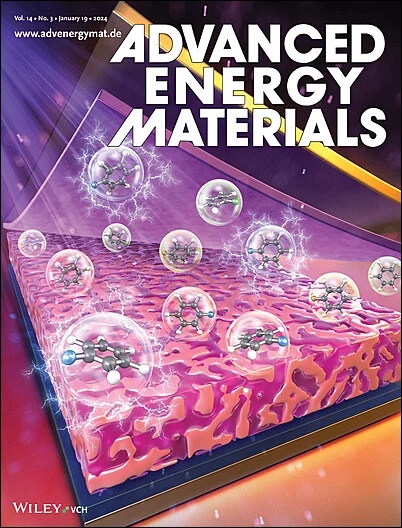In Situ Dual Crosslinked Composite Quasi‐Solid Electrolytes Enable Multiple Continuous Ion Transport Channels for Ultra‐Long Cycle and High Load Lithium Metal Batteries
IF 26
1区 材料科学
Q1 CHEMISTRY, PHYSICAL
引用次数: 0
Abstract
Composite quasi‐solid electrolytes (CQSEs) have emerged as promising candidates for solid‐state lithium metal batteries (SSLMBs) through synergistic integration of inorganic fillers and polymer matrices. However, intrinsic interfacial incompatibility between organic/inorganic phases impedes continuous Li⁺ migration pathways, leading to compromised ionic dynamics and cycling stability. In this work, surface‐modifiable lithiated zeolite (LiZSM‐5) is utilized for functional group grafting and designing a hemiacetal‐amine polymer (Trimer) with fast ion conduction. A dual‐crosslinked CQSE with multiple continuous Li原位双交联复合准固体电解质为超长循环和高负载锂金属电池提供了多个连续离子传输通道
复合准固体电解质(CQSEs)通过无机填料和聚合物基质的协同集成,成为固态锂金属电池(sslmb)的有前途的候选者。然而,有机/无机相之间固有的界面不相容性阻碍了Li +的连续迁移路径,导致离子动力学和循环稳定性受损。在这项工作中,利用表面改性的锂化沸石(LiZSM - 5)进行官能团接枝和设计具有快速离子传导的半缩醛胺聚合物(Trimer)。通过原位聚合获得了具有多个连续Li+传输通道的双交联CQSE,该通道通过集成的沸石框架和聚合物传导网络。结合实验和计算分析表明,丰富的共聚物链段与LiZSM‐5上的Lewis酸位点协同作用,优化了Li⁺的传输途径,实现了优异的离子电导率(3.7 mS cm−1)和迁移数(0.89)。优化后的CQSE在Li对称电池中实现了超过11000 h的超长循环稳定性,并在LiNi0.8Co0.1Mn0.1O2|CQSE|Li满电池中在0.5 C高活性物质负载下维持了800次循环。值得注意的是,1 Ah软包电池在机械滥用测试中显示出出色的循环稳定性和出色的安全特性。这种界面工程策略为通过有机/无机相协调构建连续离子传输网络提供了基本见解,为可扩展的高能量密度电池提供了有前途的途径。
本文章由计算机程序翻译,如有差异,请以英文原文为准。
求助全文
约1分钟内获得全文
求助全文
来源期刊

Advanced Energy Materials
CHEMISTRY, PHYSICAL-ENERGY & FUELS
CiteScore
41.90
自引率
4.00%
发文量
889
审稿时长
1.4 months
期刊介绍:
Established in 2011, Advanced Energy Materials is an international, interdisciplinary, English-language journal that focuses on materials used in energy harvesting, conversion, and storage. It is regarded as a top-quality journal alongside Advanced Materials, Advanced Functional Materials, and Small.
With a 2022 Impact Factor of 27.8, Advanced Energy Materials is considered a prime source for the best energy-related research. The journal covers a wide range of topics in energy-related research, including organic and inorganic photovoltaics, batteries and supercapacitors, fuel cells, hydrogen generation and storage, thermoelectrics, water splitting and photocatalysis, solar fuels and thermosolar power, magnetocalorics, and piezoelectronics.
The readership of Advanced Energy Materials includes materials scientists, chemists, physicists, and engineers in both academia and industry. The journal is indexed in various databases and collections, such as Advanced Technologies & Aerospace Database, FIZ Karlsruhe, INSPEC (IET), Science Citation Index Expanded, Technology Collection, and Web of Science, among others.
 求助内容:
求助内容: 应助结果提醒方式:
应助结果提醒方式:


